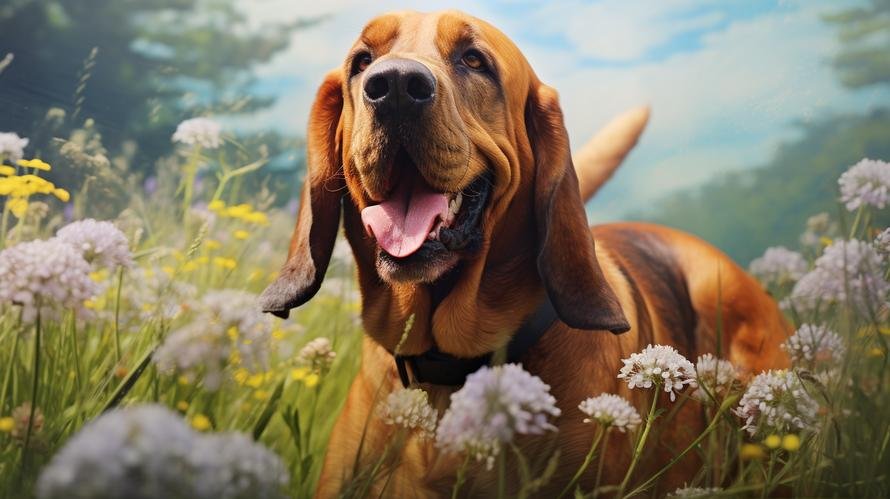Once upon a time, in the world of villains and detectives, in movies filled with suspense and drama, stood a fearless, droopy-eyed detective: the Bloodhound! This iconic breed, famous for its distinct wrinkled skin and extraordinary sense of smell, stole the show as the relentless crime-solving hero. Now, you wouldn’t be alone in thinking, “Could this powerful dog be dangerous?” We’re going to take a deep dive into the truth about the Bloodhound.
First, let’s mesmerize you with an amazing fact. Did you know that the Bloodhound holds the world record for the dog with the best smelling nose? Yes! In fact, the Bloodhound’s scenting ability is so accurate that a trail worked by a trained Bloodhound is admissible in a court of law. That’s how impressive these dogs are!
But down to the big question. Can these indefatigable trackers, blessed with such strength and distinctive noses, be dangerous? The answer will surprise you.
Instead of being a danger, Bloodhounds are actually … wait for it… exceptionally kind-hearted and affectionate! Because of their sweet nature, Bloodhounds have often been likened to giant teddy bears!
Bloodhounds are calm, patient, and hardly ever aggressive towards humans or other dogs. They have an all-around gentle disposition which makes them good companions for families, including those with children or other pets. They’re even known to be a little bit on the lazy side, preferring to lounge and sleep rather than go on the offensive.
But don’t let that fool you into thinking they’re always cuddly and laid-back. When they catch a scent they are interested in, Bloodhounds can become stubborn and focused. They might pull on the leash or try to dig under the fence to follow that intriguing smell. These moments of single-mindedness are about as troublesome as a healthy, well-adjusted Bloodhound is likely to get.
So how did the belief arise that Bloodhounds could be dangerous? This misconception probably stems from their size and history. Bloodhounds are, undeniably, large canines. The average Bloodhound stands 23 to 27 inches tall and can weigh between 80 to 110 pounds.
Besides, Bloodhounds were originally bred for tracking game and hunting. Their unparalleled sense of smell and tenacity on a scent trail made them invaluable companions for hunters. Over time, this scent-tracking skill has been used to help law enforcement agencies locate missing people and escaped criminals.
However, it’s critical to remember that being a good tracker doesn’t equate to being aggressive or dangerous. Bloodhounds don’t chase down and attack the individuals they’re tracking. They merely use their scenting abilities to locate them.
Now, as an aspiring Bloodhound owner, you might wonder: How should I handle this breed to ensure they remain friendly and non-threatening? Here comes the valuable advice.
Like any dog, Bloodhounds need consistent, positive training from a young age. With these dogs, it’s important to teach them recall commands to help keep their inquisitive noses out of trouble. Early socialization helps as well, introducing them to a variety of people, pets, and environments in a positive manner. This exposure will help your Bloodhound grow to be a well-adjusted, friendly, and relaxed dog.
Also remember, while generally mild-mannered, Bloodhounds can be ‘determined’ (read: stubborn!). So, your patience during training may be tested. But resist the temptation to use harsh training methods. The gentle soul of a Bloodhound responds best to kindness and positive reinforcement.
Exercise is another crucial factor. Keep in mind that while they love their nap times, Bloodhounds are an active breed. Regular walks, play sessions, and mental stimulation through scent games can help keep them happy and healthy.
Finally, a well-balanced diet is a must. Because they are a large breed, Bloodhounds are prone to certain health problems like hip dysplasia. A nutritious diet can help prevent such issues. Make sure your canine is consuming the right quantity and quality of food to maintain optimal weight and overall health.
Taking all this into account, we see that a Bloodhound isn’t a dangerous dog but a gentle giant. They’re lovable, affectionate, and, when provided with proper training, become loyal companions. If you’re willing to shower them with kindness, keep up with their exercise needs, and guide them through consistent, positive training, there is no reason to fear a Bloodhound.
So, the next time you see a Bloodhound romping its way down a movie screen, trailing a fugitive, remember, while they may be relentless detectives, at heart, they’re as docile as dogs can get. Rather than being a threat to 221B Baker Street or your living room, these legendary ‘super sniffers’ could well be your future loyal companions, bringing a whole lot of love and a bit of mystery to your life!



